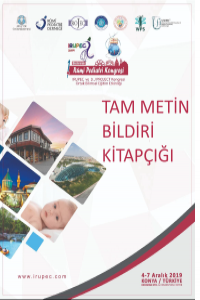Abstract
References
- References 1. Feit LR. Syncope in the pediatric patient: diagnosis, pathophysiology, and treatment. Adv Pediatr 1996;43:469–94. 2. Kanjwal K, Calkins H. Syncope in children and adolescents. Cardiac Electrophysiol Clin 2013;5:443–55. 3. Driscoll DJ, Jacobsen SJ, Porter CJ, Wollan PC. Syncope in children and adolescents. J Am Coll Cardiol 1997;29:1039–45. 4. Friedman NR, Ghosh D, Moodley M. Syncope and paroxysmal disorders other than epilepsy. In: Swaiman KF, Ashwal S, Ferriero DM, Schor NF, editors. Swaiman's Pediatric Neurology: Principles and Practice. 5th ed. China: Elsevier, Inc; 2012. p. 906–10 5. Singhi P, Saini AG. Syncope in Pediatric Practice. Indian J Pediatr 2018 ;85(8):636-640. 6. Matoth I, Taustein I, Kay BS, Shapira YA. Overuse of EEG in the evaluation of common neurologic conditions. Pediatr Neurol 2002;27:378–83. 7. Steinberg LA, Knilans TK. Syncope in children: Diagnostic tests have a high cost and low yield. J Pediatr 2005;146:355–8. 8. Bayram E, Kır M, Topçu Y, Akıncı G, Hız S, Sağın Saylam G. Senkop yakınması ile başvuran olguların retrospektif değerlendirilmesi. Turkiye Klinikleri J Pediatr 2011;20:210-3. 9. Steinberg LA, Knilans TK Syncope in children: diagnostic tests have a high cost and low yield. J Pediatr 2005 ; 146:355–358
Abstract
Aim: The aim of this study was to evaluate the clinical characteristics, etiology, and the value of neurologic investigations in the diagnosis of syncope in children.
Material and Method : The records of 218 patients (124 female, 94 male; mean age: 12.8 ± 4.1) admitted to our pediatric neurology outpatient clinic between January 2016 and December 2018 were retrospectively reviewed for age, sex, number of syncopal events, history of syncope, results of neurological diagnostic tests. Patients with known epilepsy, no eyewitness during syncope, and patients with structural heart disease or arrhythmia on cardiologic examination were excluded.
Results: Eighty six (39.4%) patients had one syncopal event, 80 (36.7%) patients had two, 31 (14.2%) patients had three and 21 (9.6%) patients had more than three syncopal attacks. Prodromal findings before syncope were present in 80 % of patients, urinary incontinence during syncope were present in 6%, motor findings were present in 18.3%, postsyncopal findings were present in 14.2%. Twenty-one (9.6%) patients had a family history of epilepsy. Electroencephalography (EEG) was performed in all patients and revealed epileptic discharges in 19 (8.7%) of them. Neuroimaging studies were performed in 97 (44.4%) patients and revealed incidental white-matter lesions in 10(10.3%), mega sisterna magna in 6(6.1%), asymmetry of the lateral ventricles in 5(5.1%), temporal lobe arachnoid cyst in 2(2%), hydrocephalus in 1 (1%), dysgenesis of corpus callosum in 1 (1%), eosinophilic granuloma in 1 (1%) and leukodystrophy in 1 (1%). The etiology was neurally mediated syncope in 181 patients (83%), convulsive/epileptic syncope in 19 patients (8.7%), psychogenic pseudosyncope in 16 patients (7.3%), metabolic in 1 patient (1%), drug induced syncope in 1 patient (1%).
Neurally- mediated syncope (NMS) was further grouped as vasovagal (n=172), reflex-anoxic (breath holding) (n=6), situational(post micturition syncope , n=6). It was seen that 79.7% of vasovagal syncopes were caused by postural orthostatic condition and 20.3% were caused by pain stimulation.
Conclusion: The history and comprehensive physical examination in children are in fact largely sufficient in the differential diagnosis of non-cardiogenic syncope. Although the contribution of neuroimaging to the etiology and diagnosis is very limited, electroencephalography may be helpful in diagnosis and treatment management in selected cases.
References
- References 1. Feit LR. Syncope in the pediatric patient: diagnosis, pathophysiology, and treatment. Adv Pediatr 1996;43:469–94. 2. Kanjwal K, Calkins H. Syncope in children and adolescents. Cardiac Electrophysiol Clin 2013;5:443–55. 3. Driscoll DJ, Jacobsen SJ, Porter CJ, Wollan PC. Syncope in children and adolescents. J Am Coll Cardiol 1997;29:1039–45. 4. Friedman NR, Ghosh D, Moodley M. Syncope and paroxysmal disorders other than epilepsy. In: Swaiman KF, Ashwal S, Ferriero DM, Schor NF, editors. Swaiman's Pediatric Neurology: Principles and Practice. 5th ed. China: Elsevier, Inc; 2012. p. 906–10 5. Singhi P, Saini AG. Syncope in Pediatric Practice. Indian J Pediatr 2018 ;85(8):636-640. 6. Matoth I, Taustein I, Kay BS, Shapira YA. Overuse of EEG in the evaluation of common neurologic conditions. Pediatr Neurol 2002;27:378–83. 7. Steinberg LA, Knilans TK. Syncope in children: Diagnostic tests have a high cost and low yield. J Pediatr 2005;146:355–8. 8. Bayram E, Kır M, Topçu Y, Akıncı G, Hız S, Sağın Saylam G. Senkop yakınması ile başvuran olguların retrospektif değerlendirilmesi. Turkiye Klinikleri J Pediatr 2011;20:210-3. 9. Steinberg LA, Knilans TK Syncope in children: diagnostic tests have a high cost and low yield. J Pediatr 2005 ; 146:355–358
Details
| Primary Language | English |
|---|---|
| Subjects | Health Care Administration |
| Journal Section | Congress Proceedings |
| Authors | |
| Publication Date | December 10, 2019 |
| Acceptance Date | January 16, 2020 |
| Published in Issue | Year 2019 Volume: 7 Issue: Ek - IRUPEC 2019 Kongresi Tam Metin Bildirileri |

